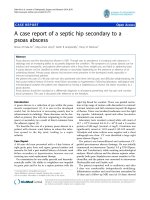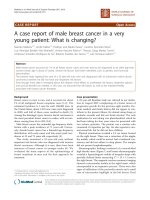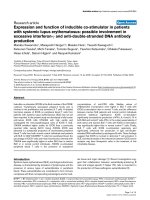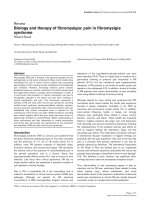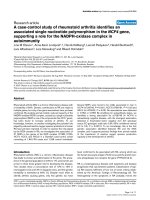Báo cáo y học: "A new association of multiple congenital anomalies/mental retardation syndrome with bradycardia-tachycardia syndrome: a case report" potx
Bạn đang xem bản rút gọn của tài liệu. Xem và tải ngay bản đầy đủ của tài liệu tại đây (1.67 MB, 5 trang )
BioMed Central
Page 1 of 5
(page number not for citation purposes)
Journal of Medical Case Reports
Open Access
Case report
A new association of multiple congenital anomalies/mental
retardation syndrome with bradycardia-tachycardia syndrome: a
case report
Chinnamuthu Murugesan*, Pradeep Kumar and Kanchi Muralidhar
Address: Department of Anesthesia, Narayana Hrudayalaya Institute of Medical Sciences, Bangalore, India
Email: Chinnamuthu Murugesan* - ; Pradeep Kumar - ;
Kanchi Muralidhar -
* Corresponding author
Abstract
Introduction: Congenital bradycardia-tachycardia syndrome is a rare disorder. Its association
with multiple congenital anomalies/mental retardation (MCA/MR) syndrome is exceptional.
Case presentation: We report a case of a new association of MCA/MR with bradycardia-
tachycardia syndrome in an 18-year-old Indian man. This syndrome is characterized by mental
retardation with delayed development of milestones, progressive scoliosis, cryptorchidism,
asymmetrical limbs involving both the upper and lower limbs, sleep apnea syndrome, bradycardia-
tachycardia syndrome and Dandy-Walker syndrome. Our patient was admitted for septoplasty
with adenoidectomy. Patients with MCA/MR with bradycardia-tachycardia syndrome pose a unique
challenge to the anesthesiologist. Establishing a good rapport with these patients is imperative. In
addition to that, the anesthesiologist should anticipate the difficulty in intubation and rhythm
abnormalities during the peri-operative period. Bradycardia or sinus arrest is a well-known
complication during the induction and maintenance of anesthesia. Lignocaine should be used with
caution in patients with bradycardia-tachycardia syndrome. Monitoring of ventilation parameters
(end-tidal CO
2
, SPO
2
, airway pressure) is essential as these patients are prone to develop
pulmonary artery hypertension secondary to sleep apnea syndrome.
Conclusion: Based on our clinical experience in detailed pre-operative evaluation and planning,
we would emphasize peri-operative anticipation and monitoring for dysrhythmias in patients with
MCA/MR and bradycardia-tachycardia syndrome undergoing any surgical procedure.
Introduction
Congenital bradycardia-tachycardia syndrome is a rare
disorder [1]. Its association with multiple congenital
anomalies/mental retardation (MCA/MR) syndrome is
exceptional. We report a new association of MCA/MR
with bradycardia-tachycardia syndrome. Anesthetic man-
agement in these patients is challenging and it requires
careful pre-operative evaluation and planning, and ade-
quate peri-operative monitoring is essential.
Case presentation
An 18-year-old Indian man was admitted for septoplasty
with adenoidectomy. He was diagnosed as having MCA/
MR syndrome, characterized by mental retardation with
Published: 1 December 2009
Journal of Medical Case Reports 2009, 3:9309 doi:10.1186/1752-1947-3-9309
Received: 20 December 2008
Accepted: 1 December 2009
This article is available from: />© 2009 Murugesan et al; licensee BioMed Central Ltd.
This is an Open Access article distributed under the terms of the Creative Commons Attribution License ( />),
which permits unrestricted use, distribution, and reproduction in any medium, provided the original work is properly cited.
Journal of Medical Case Reports 2009, 3:9309 />Page 2 of 5
(page number not for citation purposes)
delayed development of milestones, progressive scoliosis,
cryptorchidism, asymmetrical limbs that involve both the
upper and lower limbs, supernumerary nipples (five),
progressive myopia, obesity, sleep apnea syndrome,
bradycardia-tachycardia syndrome and Dandy-Walker
syndrome. His chromosomal study performed at the age
of 5 was unremarkable (Figure 1).
He was diagnosed as having bradycardia-tachycardia syn-
drome at the age of 6 months. A pediatric cardiologist
advised the fitting of a permanent pacemaker as he had
recurrent episodes of syncopal attacks, but his parents
refused permission. According to them, syncopal attacks
were transient in nature, lasting for a few seconds and
clearing without any active medical intervention. A recent
24-hour Holter electrocardiogram (ECG) monitoring
revealed bradycardia-tachycardia syndrome with sinus
pauses (Figure 2). Of late, he had developed recurrent
upper airway obstruction with excessive snoring during
sleep. He was diagnosed as having a deviated nasal sep-
tum and enlarged adenoids for which he was advised to
undergo septoplasty with adenoidectomy. In view of the
upper airway obstruction caused by deviation of the nasal
septum and hypertrophied adenoids, the treating physi-
cian suggested that this operation would definitely benefit
this patient.
Radiography of his chest and abdomen showed scoliosis
involving the thoracic and lumbar spine (Figure 3). There
was restricted excursion of movements of the right
hemithorax during inspiration. In addition, he was found
to have been suffering from sleep apnea syndrome (SAS)
for the past 6 months. However, polysomnography could
not be performed as he was highly uncooperative. Arterial
blood gas revealed PaO
2
of 93 mmHg and PaCO
2
of 34
mmHg with room air. Echocardiography showed normal
biventricular function with tricuspid regurgitation and
with a systolic gradient of 30 mmHg across the tricuspid
valve. His pre-operative blood investigations including
hemoglobin, liver function tests, thyroid function test and
serum creatinine were within normal limits.
The patient was categorized as American Society of
Anesthesiology (ASA) class 3, and general anesthesia was
administered for the proposed surgery. Non-invasive tran-
scutaneous pacemaker (NTP) paddles (Marquette defi-
brillation/pacing/monitoring pads, GE Medical Systems,
Milwaukee, WI, USA) were attached to his chest wall.
Chromosomal study returning normal resultsFigure 1
Chromosomal study returning normal results.
Journal of Medical Case Reports 2009, 3:9309 />Page 3 of 5
(page number not for citation purposes)
Anesthesia was induced with propofol and fentanyl; tra-
cheal intubation was achieved with rocuronium. A 7.0
mm cuffed endotracheal tube was inserted into his tra-
chea without any difficulty. Anesthesia was maintained
with an inhalational mixture of O
2
+ N
2
O (50:50) and iso-
flurane (1%). Standard intra-operative monitoring was
adopted which included 5-lead ECG, non-invasive blood
pressure, ETCO
2
, SPO
2
and airway pressure. A 5.0 F sheath
was inserted into the right internal jugular vein following
induction of the anesthesia enabling insertion of the
transvenous-pacing catheter in the event of bradycardia.
Hemodynamic parameters were maintained within nor-
mal limits during the intra-operative period. Recovery
from anesthesia was uneventful and his trachea was extu-
bated at the end of the procedure. Postoperatively, the
patient was intensively monitored for rhythm abnormali-
ties. In the intensive care unit, he developed a fall in heart
rate to 78/minute with sinus pauses, which was effectively
treated with intravenous atropine. However, he did not
require the temporary pacing during the peri-operative
Bradycardia-tachycardia syndrome with sinus pauses on 24-hour Holter monitoringFigure 2
Bradycardia-tachycardia syndrome with sinus pauses on 24-hour Holter monitoring.
Journal of Medical Case Reports 2009, 3:9309 />Page 4 of 5
(page number not for citation purposes)
period. He was discharged from hospital 2 days later. Dur-
ing the follow-up period 1 month after the operation, the
patient showed symptomatic improvement in upper air-
way obstruction.
Discussion
Bradycardia-tachycardia syndrome usually reflects the
presence of sinoatrial disease, where episodes of
supraventricular tachycardia complicate sinus bradycardia
with or without periods of sinus arrest or sinoatrial block.
Dizziness, syncope or convulsions may result from cere-
bral ischemia secondary to bradycardia, and tachycardia
may cause palpitation, dyspnea and chest pain. The etiol-
ogy of this syndrome is not known, but associations with
coronary artery disease, thyrotoxicosis, cardiomyopathy,
amyloidosis, diabetes and cardiac surgery have been
reported [2]. However, to the best of our knowledge, its
association with MCA/MR syndrome has not been
described in the literature.
We report the case of a patient with MCA/MR syndrome
with bradycardia-tachycardia syndrome (probably con-
genital) scheduled for septoplasty with adenoidectomy.
Patients with MCA/MR with bradycardia-tachycardia syn-
drome pose a unique challenge to the anesthesiologist.
Establishing a good rapport with these patients is impera-
tive. Anesthetic considerations include a) anticipation of
difficulties in intubation due to restricted neck move-
ments, short neck, and tracheal deviation; b) rhythm
abnormalities during the peri-operative period; and c)
adequate attention towards skeletal abnormalities, for
example, scoliosis, as evident in this patient.
Bradycardia or sinus arrest is a well-known complication
during the induction and maintenance of anesthesia [3].
This issue can be overcome by placing a temporary trans-
venous pacemaker [4] or with the use of NTP [5]. Hemo-
dynamic instability caused by sinus tachycardia or
supraventricular tachycardia during the intra-operative
period can be treated either with cardioversion or phar-
macological measures [6]. Lignocaine should be used
with caution in patients with bradycardia-tachycardia syn-
drome. It is presumed that lignocaine directly depresses
the sinus node automaticity in these patients [7].
Our patient had been diagnosed previously as having SAS.
Patients with SAS are sensitive to all central depressant
drugs, with upper airway obstruction or respiratory arrest
occurring even with a minimal dose of sedatives, hypnot-
ics or narcotics [8]. Anesthetic drugs should be adminis-
tered by titration to the clinical effects, preferably using
short-acting drugs. In one study, it was found that the
prevalence of SAS is ten-fold higher in patients with
bradycardia-tachycardia syndrome than in the general
population. This observation reveals that there may be a
relationship between these two syndromes [9].
Monitoring of ventilation parameters (ETCO
2
, SPO
2
, air-
way pressure) is essential as these patients are prone to
develop pulmonary artery hypertension secondary to SAS
[7] or scoliosis. In our patient, echocardiography revealed
tricuspid regurgitation with a systolic pressure gradient of
30 mmHg, which indicates mild pulmonary artery hyper-
tension.
Conclusion
Based on our clinical experience, we emphasize the
importance of detailed pre-operative evaluation and plan-
ning, and peri-operative anticipation and monitoring for
dysrhythmias in patients with MCA/MR and bradycardia-
tachycardia syndrome undergoing any surgical procedure.
Abbreviations
MCA/MR: multiple congenital anomalies/mental retarda-
tion; ECG: electrocardiogram; SAS: sleep apnea syndrome;
ASA: American Society of Anesthesiology; NTP: non-inva-
sive transcutaneous pacemaker.
Scoliosis of thoracic and lumbar spineFigure 3
Scoliosis of thoracic and lumbar spine.
Publish with BioMed Central and every
scientist can read your work free of charge
"BioMed Central will be the most significant development for
disseminating the results of biomedical research in our lifetime."
Sir Paul Nurse, Cancer Research UK
Your research papers will be:
available free of charge to the entire biomedical community
peer reviewed and published immediately upon acceptance
cited in PubMed and archived on PubMed Central
yours — you keep the copyright
Submit your manuscript here:
/>BioMedcentral
Journal of Medical Case Reports 2009, 3:9309 />Page 5 of 5
(page number not for citation purposes)
Consent
Written informed consent was obtained from the patient's
parents for publication of this case report and any accom-
panying images. A copy of the written consent is available
for review by the Editor-in-Chief of this journal.
Competing interests
The authors declare that they have no competing interests.
Authors' contributions
CM provided patient care, acquisition of data and litera-
ture review. KM was involved in drafting the manuscript.
PK was involved in patient care and interpretation of data.
References
1. Ben Ameur Y, Hmam M, Battikh K, Mlika A, Terras M, Longo S,
Kraiem S, Slimane ML: Congenital sick sinus syndrome in a
healthy heart: case report. Tunis Med 2003, 81:432-436.
2. Brown AK, Primhak RA, Newton P: Use of amiodarone in brady-
cardia-tachycardia syndrome. Br Heart J 1978, 40:1149-1152.
3. Nakamura S, Nishiyama T, Hanaoka K: General anesthesia for a
patient with asymptomatic sick sinus syndrome. Masui 2005,
54:912-913.
4. Murakawa T, Ishihara H, Matsuki A: Marked bradycardia during
anesthetic induction treated with temporary cardiac pacing
in a patient with latent sick sinus syndrome. Masui 2001,
50:65-68.
5. Im SH, Han MH, Kim SH: Transcutaneous temporary cardiac
pacing in carotid stenting: noninvasive prevention of angi-
oplasty-induced bradycardia and hypotension. J Endovasc Ther
2008, 15:110-116.
6. Padeletti L, Santini M, Boriani G, Italian AT500 Registry Investigators:
Long-term reduction of atrial tachyarrhythmia recurrences
in patients paced for bradycardia-tachycardia syndrome.
Heart Rhythm 2005, 2:1047-1057.
7. Ishii Y, Mitsuda H, Eno S: Electrophysiological effects of lido-
caine in sick sinus syndrome. Jpn Heart J 1980, 21:27-34.
8. Boushra NN: Anaesthetic management of patients with sleep
apnoea syndrome. Can J Anaesth 1996, 43:599-616.
9. Martí Almor J, Félez Flor M, Balcells E: Prevalence of obstructive
sleep apnea syndrome in patients with sick sinus syndrome.
Rev Esp Cardiol 2006, 59:28-32.


